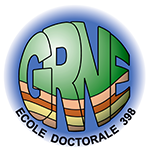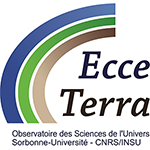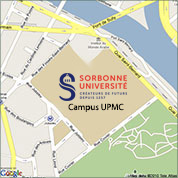Séminaire ISTeP - Timm John
(U. Berlin)
Dehydrating slabs – flow structures, mechanisms, rates and some geochemical consequences for subduction zone settings
At subduction zones, seawater-altered oceanic lithosphere recycles back into the mantle, heats up during descent and releases fluids by devolatilization of hydrous minerals. Large-scale fluid flow resulting from this dehydration is implicit in recent models for the formation of arc magmas and appears to be linked to intraslab seismicity. However, the mechanisms as well as spatial and temporal scales of this fluid flow are only poorly known. Exposures of veins in oceanic lithosphere, metamorphosed at high pressures in subduction zones, provide direct evidence for fluid mobility within subducting slabs. Based on field observations and eletronmicroscopy data we delevop a mechanistic model of porosity formation and initiation of intraslab fluid flow. We also quantify the duration of dehydration-related fluid flow through subducting oceanic plates. Using stable (Li, Ca) isotope data combined with Li-diffusion and reaction kinetic modelling, we demonstrate that large amounts of fluid can be transported along major conduits over km distances in a pulse-like manner through slabs over surprisingly short time periods of ~200 years. This indicates that even though the overall slab dehydration is a continuous process, dehydrating slabs release their fluid by short-lived, channelized fluid-flow events, involving aseismic mobile hydraulic fractures that rapidly traverse the subducting slabs.
03/06/2015 à 12h30, Salle Fourcade (Tour 55/56, 4ème étage)
Egalement dans la rubrique
- Séminaire ISTeP - Chrystèle Sanloup
- Séminaire ISTeP - Marco Scambelluri
- Séminaire ISTeP - Déborah Chavrit
- Séminaire ISTeP - Evgueni Burov
- Séminaire ISTeP - Anne Le Friant
- Séminaire ISTeP - Pierre Valla
- Séminaire ISTeP - Ramadan Ghalayini
- Séminaire ISTeP - Matthias Delescluse
- Séminaire ISTeP - Séverine Moune
- Séminaire ISTeP - Lucie Tajcmanova
- Séminaire ISTeP - Gabriel Coelho
- Séminaire ISTeP - Laurie Bougeois
- Séminaire ISTeP - Jacques Touret
- Séminaire ISTeP - Sanae El Janyani
- Séminaire ISTeP - Arthur Paté
- Séminaire ISTeP - Nicolas Beaudoin
- Séminaire ISTeP - Kosuke Ueda
- Séminaire ISTeP - Ali Hannouche
- Séminaire ISTeP - Benjamin Cochain
- Séminaire ISTeP - Behzad Nasri
- Séminaire ISTeP - Daniel Pastor Galan
- Séminaire ISTeP - Sara Lafuerza Colas
- Séminaire ISTeP - Jean-Pierre Suc
- Séminaire ISTeP - Pierpaolo Zuddas
- Séminaire ISTeP - Agnès Elmaleh
- Séminaire ISTeP - John Wakabayashi
- Séminaire ISTeP - Jonas Ruh
Chiffres clés (Mars 2025)
L'ISTeP comprend 131 membres dont :
Permanents (66)
- Professeurs : 17 (+2 PAST)
- Maîtres de conférence : 26
- Directeurs de recherche CNRS : 1
- Chargés de recherche CNRS : 1
- ITA : 19
Personnels non permanents (65)
- Collaborateurs bénévoles / émérites : 17
- Chaire de professeur junior : 1
- Enseignants-chercheurs contractuel : 2
- 1 MCF accueil en délégation
- ATER et Post-Docs : 9
- Doctorants : 32
- ITA-BIATSS : 3





